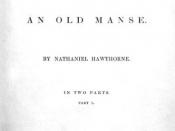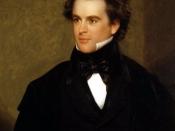Henry W. Longfellow once said, Hawthorne "was a mysterious man". Longfellow knew Nathaniel Hawthorne in person not as a historian. Nathaniel Hawthorne can be understood if one looks into his past and researches one of his works. Nathaniel Hawthorne's mystery comes from his in depth look into human perception, which shines through his imagery in "Young Goodman Brown".
Nathaniel Hawthorne was born into a Puritan family in July of 1804. His father Nathaniel Hathorne was a sea captain. His mother, Elizabeth Manning Hathorne, was the daughter of Richard Manning a blacksmith who left the industry to pursue work in the stagecoach line. Four years after Hawthorne's birth his father died of yellow fever. Hawthorne's father never saw his youngest daughter, Maria Louise. Nathaniel Hawthorne had an older sister, Elizabeth, who was two years his senior.
Hawthorne spent his early years at his grandparent's house in Salem. He did not go "to school until he was seven" (Hoeltje 27).
His sister noticed that he could read at an early age, one of his favorites was Spencer's Fairie Queen. Hawthorne's uncle, Robert Manning, sent him to a private school. In school, Hawthorne sustained a foot injury, which left him to use crutches for many years. This injury created an escape for Hawthorne, he used it to seclude himself from the world. Hawthorne started writing his first journal, in 1816, which his Uncle Richard gave to him. In 1818, "his mother removed the family from Salem" to Raymond, Maine (Hoeltje 29). In Raymond, Hawthorne's imagination grew from the wilderness and solidarity.
Hawthorne's uncle sent him to Bowdoin College in 1821. Bowdoin was a college that expected its students to follow their strict rules. Hawthorne disagreed with the school's penal code, "he fought back against this system" (Normand 25). Hawthorne rebelled and...


